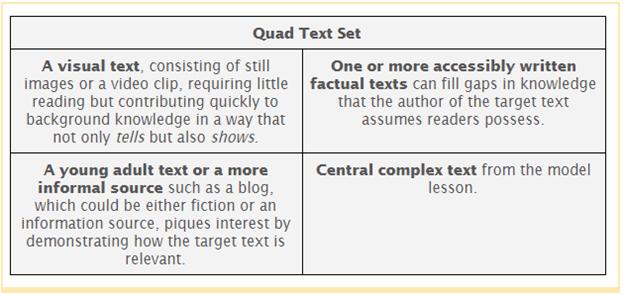Student Achievement Partners worked with a group of middle and high school educators to create a series of Knowledge-Building Model Lessons. These lessons focus on building knowledge to help students better access complex text. They include a model close reading paired with a collection of knowledge-building resources and tasks to create what is called a quad text set. In this blog post, two of the Knowledge-Building Model Lesson designers, Jenni Aberli and Lauren Trahan, share their insights from working on the project.
What is the best reason to use a knowledge-building model lesson? How might you use one of these lessons in your own teaching?
Jenni: Research shows us that many students often do not have a strong fund of knowledge that matches the demands of the text(s) they are reading. For these students, the missing knowledge creates a barrier to reading comprehension. Using a knowledge-building model lesson exposes students to necessary content in a more accessible way. This is especially helpful for students who are English learners, students with special needs, and/or students we haven’t taught to read at grade level yet.
I would use a knowledge-building model lesson as a scaffold for students. I might use it for the whole whole class or as an accelerator for specific students.
Lauren: This model is incredibly effective when teaching courses without a set curriculum or with a curriculum that is not quite aligned to grade-level standards. Sometimes instruction or courses are specifically intended to support students who we have not yet taught to read grade-level text–this instruction often lacks a set curriculum that sufficiently mirrors the rigor of on-grade-level courses. The knowledge-building model lessons include quad text sets that excite and engage middle and high school students with a variety of text formats, each paired with an instructional strategy as a way to build knowledge over the course of a lesson. This scaffolds the learning and increases accessibility while showcasing grade-appropriate content.
For teachers wanting to design a quad text set, where should they start?
Jenni: I believe the Knowledge-Building with a Model Lesson overview document is the best resource for getting started. I loved that it was so easy to follow and make sense of. I especially liked the recommendations for what type of texts should be a part of the quad text set. I could imagine a PLC dividing and conquering parts of this to build a text set.
My other favorite resource for developing your own quad texts sets is the Lightweight Text-Dependent Tasks table. We need high-quality resources and tasks, and if we have a source for easily finding and plugging in quality tasks, that makes this work all the better.
What did you learn from working on this project?
Lauren: I learned that collaboration is still the essential ingredient to solidarity in instruction. When ideas are shared in an open environment, educators are invited into a world outside the four walls of their classroom. It is in this atmosphere of collaboration that diversity thrives from the input from other uniquely run districts and states. Classrooms become blank canvases where the opportunity to engage in a growth mindset is encouraged and explored for the benefit of the students and the teacher.
Jenni: I learned how to build a text set that would grow content knowledge so that students have better access to a grade-level, more complex text. This is work that I really hadn’t done before in building a text set. I would love to take what I learned from this project and build it into my ongoing work with teachers so that they, too, can design text sets with the goal of scaffolding students into more complex text through increased knowledge.
What advice would you give teachers for building quad text sets?
Lauren: Building quad text sets invites professional development and personal growth due to the ability to stretch the meaning and value of the anchor text. Teachers need not be afraid to go outside of what is comfortable, as in, what construct the anchor text is intended to teach students. Welcoming a diverse landscape of student choice and understanding combined with a mixture of multimedia/text options is essential in keeping classroom perspective fresh and instruction relevant.
Jenni: Collaborate! While this is work that can be done alone, it is so much better done in collaboration with a colleague. Having someone work with me to look at my choices and provide suggestions and feedback for how to make it better was invaluable.
To access the knowledge-building model lessons, you can find the quad text sets paired with close-reading lessons here and the resources to build your own quad text set here.


















